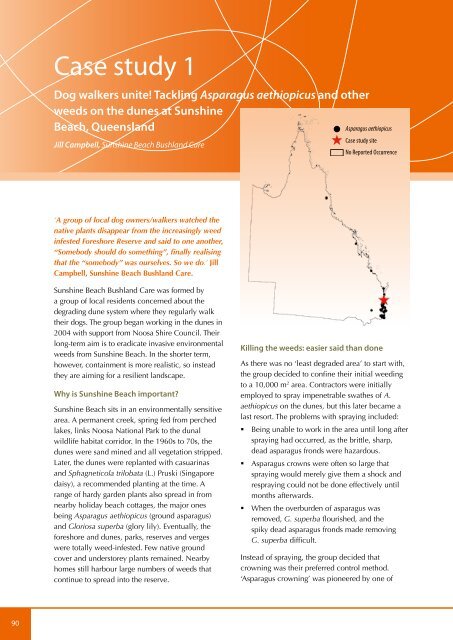Asparagus weeds - Weeds Australia
Asparagus weeds - Weeds Australia
Asparagus weeds - Weeds Australia
- No tags were found...
You also want an ePaper? Increase the reach of your titles
YUMPU automatically turns print PDFs into web optimized ePapers that Google loves.
Case study 1Dog walkers unite! Tackling <strong>Asparagus</strong> aethiopicus and other<strong>weeds</strong> on the dunes at SunshineBeach, QueenslandJill Campbell, Sunshine Beach Bushland Care! <strong>Asparagus</strong> aethiopicus^Case study siteNo Reported Occurrence‘A group of local dog owners/walkers watched thenative plants disappear from the increasingly weedinfested Foreshore Reserve and said to one another,“Somebody should do something”, finally realisingthat the “somebody” was ourselves. So we do.’ JillCampbell, Sunshine Beach Bushland Care.Sunshine Beach Bushland Care was formed bya group of local residents concerned about thedegrading dune system where they regularly walktheir dogs. The group began working in the dunes in2004 with support from Noosa Shire Council. Theirlong-term aim is to eradicate invasive environmental<strong>weeds</strong> from Sunshine Beach. In the shorter term,however, containment is more realistic, so insteadthey are aiming for a resilient landscape.Why is Sunshine Beach important?Sunshine Beach sits in an environmentally sensitivearea. A permanent creek, spring fed from perchedlakes, links Noosa National Park to the dunalwildlife habitat corridor. In the 1960s to 70s, thedunes were sand mined and all vegetation stripped.Later, the dunes were replanted with casuarinasand Sphagneticola trilobata (L.) Pruski (Singaporedaisy), a recommended planting at the time. Arange of hardy garden plants also spread in fromnearby holiday beach cottages, the major onesbeing <strong>Asparagus</strong> aethiopicus (ground asparagus)and Gloriosa superba (glory lily). Eventually, theforeshore and dunes, parks, reserves and vergeswere totally weed-infested. Few native groundcover and understorey plants remained. Nearbyhomes still harbour large numbers of <strong>weeds</strong> thatcontinue to spread into the reserve.Killing the <strong>weeds</strong>: easier said than doneAs there was no ‘least degraded area’ to start with,the group decided to confine their initial weedingto a 10,000 m 2 area. Contractors were initiallyemployed to spray impenetrable swathes of A.aethiopicus on the dunes, but this later became alast resort. The problems with spraying included:• Being unable to work in the area until long afterspraying had occurred, as the brittle, sharp,dead asparagus fronds were hazardous.• <strong>Asparagus</strong> crowns were often so large thatspraying would merely give them a shock andrespraying could not be done effectively untilmonths afterwards.• When the overburden of asparagus wasremoved, G. superba flourished, and thespiky dead asparagus fronds made removingG. superba difficult.Instead of spraying, the group decided thatcrowning was their preferred control method.‘<strong>Asparagus</strong> crowning’ was pioneered by one of90
















